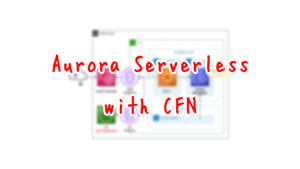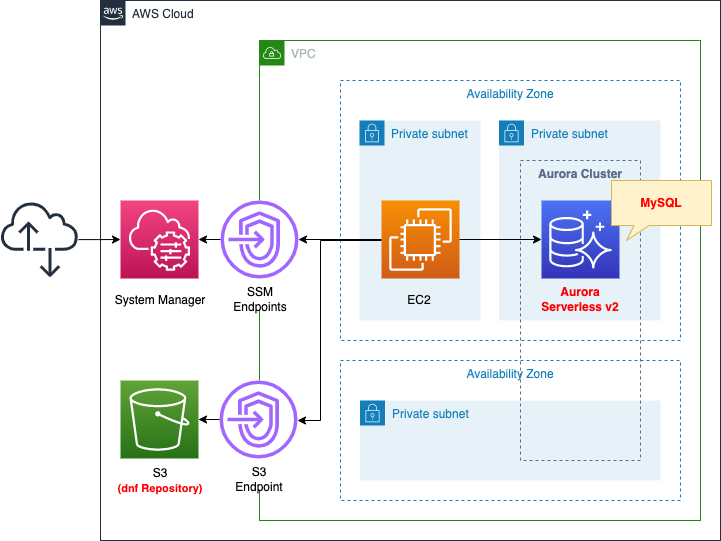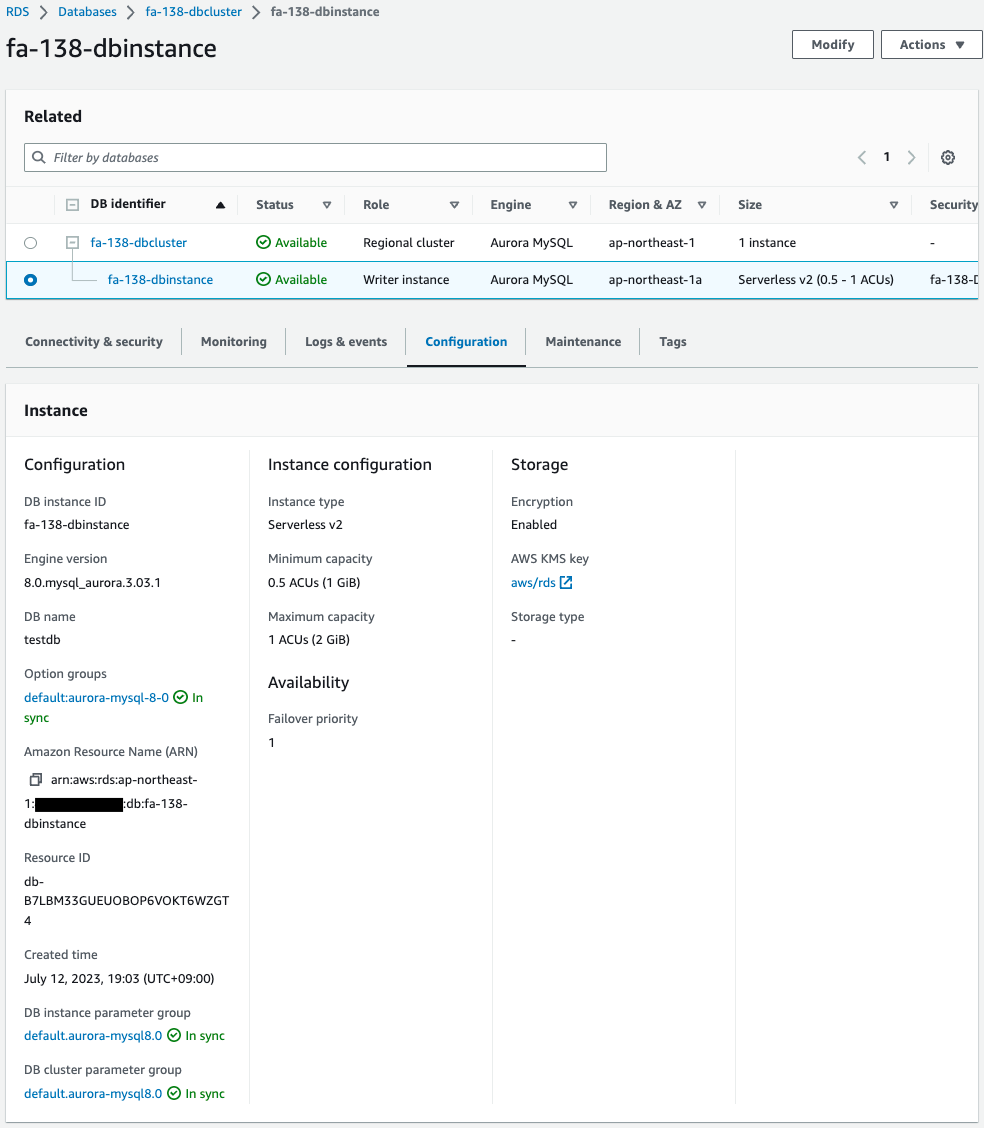Aurora Serverless v2 creation using CloudFormation
In the following pages, we have shown you how to create Aurora Serverless v1 using CloudFormation.

It was announced that Aurora Serverless v2 will also support CloudFormation on 2022/10/05.
This page uses CloudFormation to create Aurora Serverless v2.
Environment

The basic structure is the same as the page introduced at the beginning of this document.
Create Aurora Serverless v2 and associate it with two subnets with different AZs.
For DB engine, specify the latest version of MySQL type.
Create an EC2 instance.
Use it as a client to connect to Aurora Serverless.
The OS will be the latest version of Amazon Linux 2023.
CloudFormation template files
The above configuration is built with CloudFormation.
The CloudFormation templates are placed at the following URL
https://github.com/awstut-an-r/awstut-fa/tree/main/138
Explanation of key points of template files
Aurora Serverless v2
When creating Aurora Serverless v2 using CloudFormation, three resources are created.
Many parameters for each resource are the same as when creating a regular Aurora.
In this case, we will focus on parameters specific to Aurora Serverless v2.
DB Subnet Group
Resources:
DBSubnetGroup:
Type: AWS::RDS::DBSubnetGroup
Properties:
DBSubnetGroupName: dbsubnetgroup
DBSubnetGroupDescription: test subnet group
SubnetIds:
- !Ref DBSubnet1
- !Ref DBSubnet2
Code language: YAML (yaml)No special configuration is required here.
Specify two or more subnets on which to place the DB clusters described below.
The point is the AZ where each subnet is created.
Note that each must be created in a different AZ.
Aurora Cluster
Resources:
DBCluster:
Type: AWS::RDS::DBCluster
Properties:
DatabaseName: !Ref DBName
DBClusterIdentifier: !Sub "${Prefix}-dbcluster"
DBSubnetGroupName: !Ref DBSubnetGroup
Engine: !Ref DBEngine
EngineVersion: !Ref DBEngineVersion
MasterUsername: !Ref DBMasterUsername
MasterUserPassword: !Ref DBMasterUserPassword
ServerlessV2ScalingConfiguration:
MaxCapacity: 1.0
MinCapacity: 0.5
StorageEncrypted: true
VpcSecurityGroupIds:
- !Ref DBSecurityGroup
Code language: YAML (yaml)There are three points.
The first point is the Engine property.
In Aurora Serverless v2, you can choose MySQL or PostgreSQL as the DB engine.
Since we will create a MySQL type Aurora Serverless v2, we will specify “aurora-mysql” for this property.
The second point is the EngineVersion property.
This property allows you to specify the DB engine version.
Refer to the following page to check the versions that can be specified using the AWS CLI.
The version of the MySQL type that can be selected in the ap-northeast-1 region can be checked with the following command.
$ aws rds describe-orderable-db-instance-options \
--engine aurora-mysql \
--db-instance-class db.serverless \
--region ap-northeast-1 \
--query 'OrderableDBInstanceOptions[].[EngineVersion]' \
--output text
8.0.mysql_aurora.3.02.0
8.0.mysql_aurora.3.02.1
8.0.mysql_aurora.3.02.2
8.0.mysql_aurora.3.02.3
8.0.mysql_aurora.3.03.0
8.0.mysql_aurora.3.03.1
8.0.mysql_aurora.3.03.1
Code language: Bash (bash)In this case, specify “8.0.mysql_aurora.3.03.1” which is the latest version as of July 2023.
The third is the ServerlessV2ScalingConfiguration property.
This property defines the range of performance (ACU) that can be taken by the DB instances created in the cluster.
The unit of measure for Aurora Serverless v2 is the Aurora capacity unit (ACU).
Each ACU is a combination of approximately 2 gibibytes (GiB) of memory, corresponding CPU, and networking. You specify the database capacity range using this unit of measure.
Aurora Serverless v2 capacity
ACU values can be specified from 0.5 to 128 in increments of 0.5.
For this verification, we specify 0.5 as the minimum possible ACU value and 1.0 as the maximum (MinCapacity and MaxCapacity properties).
DB Instance
Resources:
DBInstance:
Type: AWS::RDS::DBInstance
Properties:
DBClusterIdentifier: !Ref DBCluster
DBSubnetGroupName: !Ref DBSubnetGroup
DBInstanceIdentifier: !Sub "${Prefix}-dbinstance"
DBInstanceClass: !Ref DBInstanceClass
Engine: !Ref DBEngine
AvailabilityZone: !Sub "${AWS::Region}${AvailabilityZone}"
PubliclyAccessible: false
Code language: YAML (yaml)The DBInstanceClass property is the key.
db.serverless – A special DB instance class type used by Aurora Serverless v2.
Aurora Serverless v2 instance class type
According to the above, “db.serverless” is specified for this property.
Security Group
Resources:
DBSecurityGroup:
Type: AWS::EC2::SecurityGroup
Properties:
GroupName: !Sub "${Prefix}-DBSecurityGroup"
GroupDescription: DBSecurityGroup.
VpcId: !Ref VPC
SecurityGroupIngress:
- IpProtocol: tcp
FromPort: !Ref MySQLPort
ToPort: !Ref MySQLPort
SourceSecurityGroupId: !Ref InstanceSecurityGroup
Code language: YAML (yaml)Security group to be applied to the Aurora cluster.
The settings are the same as for a normal MySQL type RDS instance.
Allow inbound communication to the port for MySQL communication (tcp/3306).
For the Source, specify the security group to be applied to the EC2 instance described below.
(Reference) EC2 instance
Resources:
Instance:
Type: AWS::EC2::Instance
Properties:
IamInstanceProfile: !Ref InstanceProfile
ImageId: !Ref ImageId
InstanceType: !Ref InstanceType
NetworkInterfaces:
- DeviceIndex: 0
SubnetId: !Ref InstanceSubnet
GroupSet:
- !Ref InstanceSecurityGroup
UserData: !Base64 |
#!/bin/bash -xe
dnf update -y
dnf install -y mariadb105
Code language: YAML (yaml)This instance is used to access Aurora Serverless v2.
So we install mariadb using the user data function.
Now prepare the client for MySQL.
For more information on the EC2 instance initialization process, please also see the following page.

Architecting
Use CloudFormation to build this environment and check its actual behavior.
Create CloudFormation stacks and check the resources in the stacks
Create CloudFormation stacks.
For information on how to create stacks and check each stack, please see the following page.

After reviewing the resources in each stack, information on the main resources created in this case is as follows
- EC2 instance: i-0ea84706be1475b7f
- Aurora cluster: fa-138-dbcluster
- Aurora cluster endpoint: fa-138-dbcluster.cluster-cl50iikpthxs.ap-northeast-1.rds.amazonaws.com
Check the Aurora cluster from the AWS Management Console.

The Aurora cluster has been successfully created.
And one DB instance is created in the cluster.

Looking at the DB instance type, we see that it was indeed created as Aurora Serverless v2.
The capacity information shows that the ACU is set between 0.5 and 1.0.
Operation Check
Now that you are ready, access the EC2 instance.
The SSM Session Manager is used to access the instance.
% aws ssm start-session --target i-0ea84706be1475b7f
...
sh-5.2$
Code language: Bash (bash)For more information on SSM Session Manager, please refer to the following page.

Next, check the installation status of the MySQL client.
sh-5.2$ dnf list installed | grep mariadb
mariadb-connector-c.aarch64 3.1.13-1.amzn2023.0.3 @amazonlinux
mariadb-connector-c-config.noarch 3.1.13-1.amzn2023.0.3 @amazonlinux
mariadb105.aarch64 3:10.5.18-1.amzn2023.0.1 @amazonlinux
mariadb105-common.aarch64 3:10.5.18-1.amzn2023.0.1 @amazonlinux
Code language: Bash (bash)You can see that MariaDB is indeed installed.
Check the version.
sh-5.2$ mariadb -V
mariadb Ver 15.1 Distrib 10.5.18-MariaDB, for Linux (aarch64) using EditLine wrapper
Code language: Bash (bash)You will see that the latest version of the client is installed.
Now that the client installation has been verified, connect to Aurora Serverless v2.
Specify the Aurora cluster endpoint and pass the port number, username and password as arguments.
sh-5.2$ mariadb -h fa-138-dbcluster.cluster-cl50iikpthxs.ap-northeast-1.rds.amazonaws.com -P 3306 -u testuser -p testdb
Enter password:
Welcome to the MariaDB monitor. Commands end with ; or \g.
Your MySQL connection id is 97
Server version: 8.0.26 Source distribution
Copyright (c) 2000, 2018, Oracle, MariaDB Corporation Ab and others.
Type 'help;' or '\h' for help. Type '\c' to clear the current input statement.
MySQL [testdb]>
Code language: Bash (bash)We were able to connect successfully.
Aurora Serverless v2 was successfully created.
Summary
Aurora Serverless v2 was created with CloudFormation.